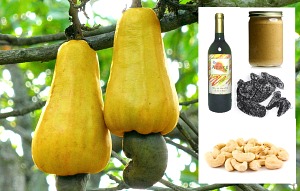 Cashew (Anacardium occindentale) is widely grown in the tropics because of its cashew and apples. The cashew apple can be eaten raw or used in the production of jam., chutney, pickles or various beverages like juice and wine. Cashew contains potassium, magnesium, phosphorous, selenium, copper and vitamins. Whether roasted, salted or sugared, the cashew nut is often used as flavorful complement to appetizers, main dishes and desserts.
Cashew (Anacardium occindentale) is widely grown in the tropics because of its cashew and apples. The cashew apple can be eaten raw or used in the production of jam., chutney, pickles or various beverages like juice and wine. Cashew contains potassium, magnesium, phosphorous, selenium, copper and vitamins. Whether roasted, salted or sugared, the cashew nut is often used as flavorful complement to appetizers, main dishes and desserts.
Processed Food Products from Cashew
Cashew Butter
Ingredients:
- 10 kilograms cashew nuts (uncooked)
- 1 gallon cooking oil
- 5 kilograms sugar
- 750 grams margarine
- 750 grams lard
- 5 teaspoon salt
Procedure:
- Fry the nuts.
- Strain the cooked nuts.
- Mix sugar, cashew nuts and teaspoon salt.
- Mix the ingredients thoroughly.
- Grind the mixtures until it becomes fine.
- Pour the margarine (liquidized) and lard (liquidized).
- Mix well until the margarine and lard are evenly distributed.
- Place the butter in a dry, clean bottle. Cover and seal, then label it.
Cashew Nuts
Ingredients:
- Cashew nuts
Procedure:
- Clean cashew nuts of foreign matter like sand, stones and dried apple.
- Dry the shelled kernel to facilitate removal of testa. Drying protects the kernel from pest and fungus attack.
- Shell big cashew nuts with the BPRE cashew nut sheller. Split the other nuts using kalukati (an indigenous tool).
- Separate the shelled pieces from the kernels. The unshelled nuts are returned to the shelling operation.
- Peel the testa manually by gently rubbing with fingers. It is important that the kernels are neither cut nor damaged during the peeling process.
- Roast the cashew nuts to release the cashew shell liquid and make the shell brittle. This will facilitate the extraction of the kernel when breaking the shell open.
- Grade the kernels for quality control. Shelled, dried and peeled kernels are graded for export according to size and condition.
- Pack into appropriate containers the cashew kernels.
Cashew Wine
Ingredients:
- 1 kilogram fresh cashew apples
- 96 grams refined sugar
- 1/2 teaspoon instant yeast
- 1/4 egg white
Procedure:
Ingredients preparation
- Select rice cashew apples.
- Wash and weigh.
- Trim both ends of the apples and slice into four equal parts.
- Weigh sliced apples.
- Add sugar equivalent to 12% of cashew weight.
- Soak the mixture for 12 to 15 minutes.
- Drain the pulp and set aside the juice extracted for fermentation.
Alcoholic fermentation
- Transfer the juice to fermenting bottle/jar about 1/4 full.
- Add 1 1/2 teaspoon yeast.
- Shake bottle in circular motion.
- Plug on cotton at the mouth of the bottle/jar.
- Set aside for two to four weeks.
- Siphon/decant the clarified wine.
- Pasteurize to 50ºC to 60ºC for three minutes.
- Pack in bottle and cover with cap bottle/jar.
- Age to desired year.
- Chill before serving.
Cashew Prunes
Ingredients:
- 1 kilogram cashew pulp
- 5 cups brown sugar
- 5 cups caramel brown liquid
- 1/2 cinnamon powder
- 1 piece star of anise
- 1/2 teaspoon salt
- 1/2 liter vinegar
- 1/2 liter water
- 1/8 teaspoon citric acid
- 1/8 teaspoon potassium sorbate
Procedure:
- Cook the cashew pulp in 50% vinegar solution (mix 1 part vinegar to 1 part water) for 10 to 15 minutes upon boiling.
- Prepare 25% syrup (mix 1/2 cup of sugar to 2 1/2 cup caramel).
- Cook the pulp in 25% syrup together with powder, salt, star of anise, citric acid and potassium sorbate for 10 to 15 minutes upon boiling.
- Soak the pulp for one to two days in the syrup.
- Adjust the sugar concentration to 50% by adding the remaining 2 1/2 cup sugar.
- Cook the mixture for another 10 to 15 minutes upon boiling.
- Soak the pulp for another one to two days.
- Drain the pulp, Arrange the pulp on trays. Sundry for one to two days.
- Cool dried prunes at room temperature.
- Pack in plastic bag or plastic container.
Source: www.trc.dost.gov.ph; Photos: en.wikipedia.org